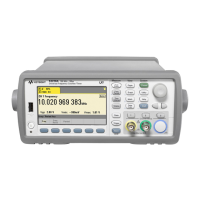6 Not Used 64 (Reserved for future use)
7 Power On 128 Power has been turned off and on since the last
time the event register was read or cleared.
l To enable specific bits, you must write a decimal value that corresponds to the binary-weighted sum of
the bits in the register. The selected bits are summarized in the "Standard Event Summary" bit (bit 5) of
the Status Byte Register.
l Use the <enable_value> parameter to specify which bits will be enabled. The decimal value specified cor-
responds to the binary-weighted sum of the bits you wish to enable in the register. For example, to
enable bit 2 (decimal value = 4), bit 3 (decimal value = 8), and bit 7 (decimal value = 128), the cor-
responding decimal value would be 140 (4 + 8 + 128).
l The *CLS (clear status) command will not clear the enable register but it does clear all bits in the event
register.
l A STATus:PRESet, SYSTem:PRESet, *CLS, or *RST command does not clear the bits in the Standard
Event enable register.
Return Format
The query reads the enable register and returns a decimal value which corresponds to
the binary-weighted sum of all bits set in the register. For example, if bit 3 (decimal
value = 8) and bit 7 (decimal value = 128) are enabled, the query command will return
"+136".
Examples
The following example enables bit 4 (decimal value = 16) in the enable register. If an Execution Error
occurs, this condition will be reported to the Status Byte Register (bit 5 will be set high).
*ESE 16
The following example returns which bits are enabled in the register.
*ESE?
Typical Response: +16
See Also
*ESR?
*STB?
Keysight 53220A/53230A Programmer's Reference 183
*ESE

